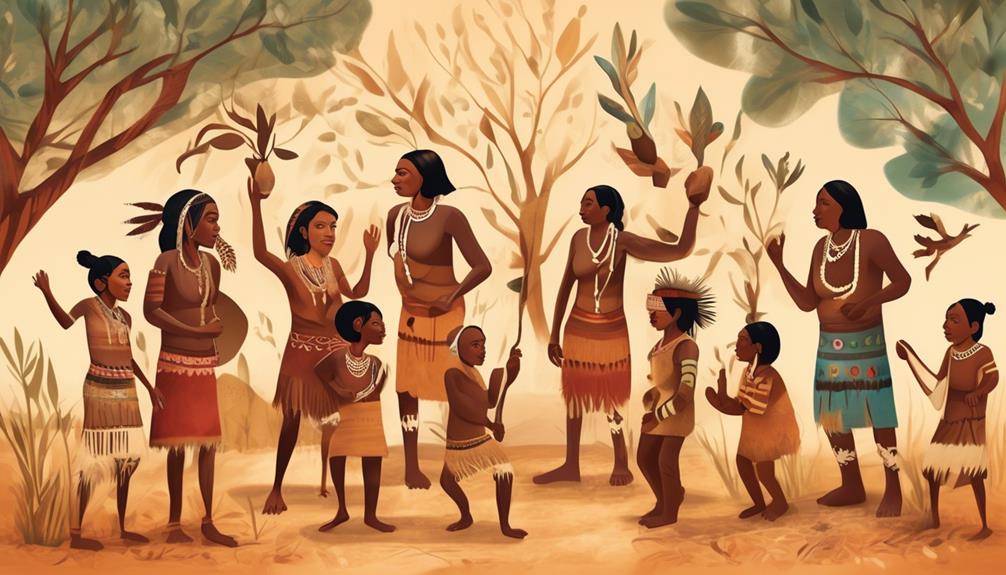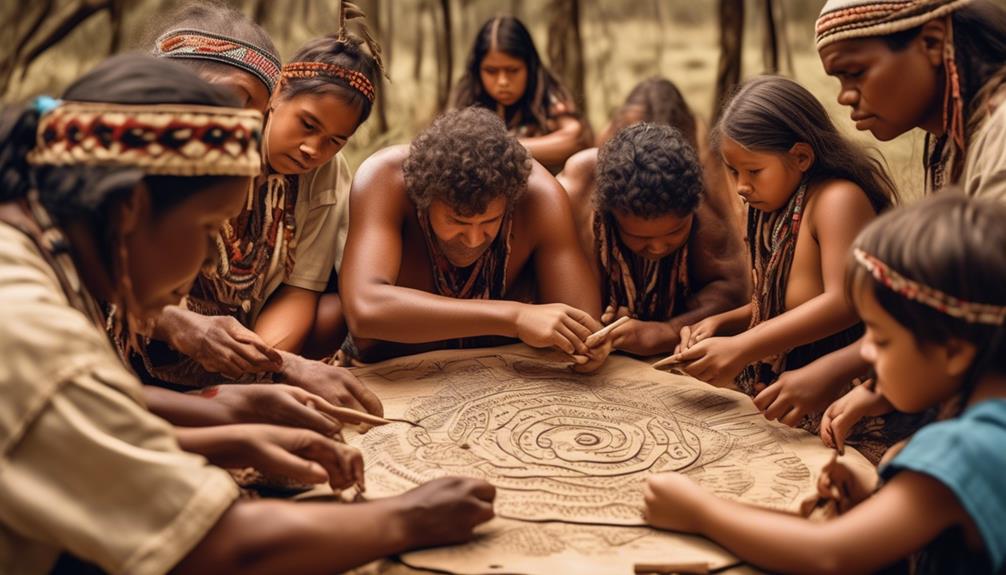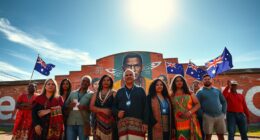As we navigate the complex process of developing policies for language preservation, it is evident that protecting Indigenous Australian languages is more than just preserving linguistic diversity; it is a vital aspect of cultural heritage.
The intricate interplay between language, identity, and community is a crucial consideration in formulating effective policies. From community collaboration to the implementation of language immersion programs, there are multifaceted strategies that necessitate careful examination and evaluation.
However, the true challenge lies in determining the most impactful and sustainable approaches that not only support the preservation of Indigenous languages but also empower the communities that safeguard them.
Key Takeaways
- Preserving and revitalizing Indigenous Australian languages is crucial for maintaining cultural heritage and fostering social cohesion within communities.
- Community collaboration and partnerships are fundamental in the successful preservation of Australian Indigenous languages.
- Effective language preservation strategies include language immersion programs, digital resources and online platforms, bilingual education programs, and funding for language documentation and research.
- Government support and recognition through language policies are vital for sustaining language revitalization efforts and promoting the diversity of Indigenous languages.
Importance of Indigenous Australian Languages
Preserving and revitalizing Indigenous Australian languages is crucial for maintaining cultural heritage and fostering social cohesion within communities.
Indigenous languages aren't just a means of communication; they're the cornerstone of cultural practices and traditions, binding Indigenous Australians to their heritage and identity.
Our commitment to language preservation is rooted in recognizing the intrinsic link between language and culture. For Aboriginal communities, language is more than just words; it embodies their worldview, history, and spiritual connection to the land.
Upholding the importance of Indigenous languages isn't only a matter of language rights but also a fundamental aspect of supporting the well-being and resilience of Indigenous communities. It's through language revitalization that we can ensure the transmission of invaluable knowledge and wisdom from one generation to another.
Policy making for language preservation must prioritize the significance of Indigenous languages, acknowledging their pivotal role in the overall development of individuals and communities.
Community Collaboration in Language Preservation

In our efforts to preserve and revitalize Indigenous Australian languages, fostering collaboration within indigenous communities and with external partners is paramount. This collaboration is essential for the success of language preservation initiatives and the revitalization of Australian Indigenous languages.
To achieve this, we must:
- Engage indigenous communities: Actively involve indigenous communities in decision-making processes and the implementation of language preservation efforts. Their active participation and leadership are crucial for the success and sustainability of language revival projects.
- Seek collaboration with experts: Partner with linguists, educators, and technology experts to develop comprehensive strategies for language preservation. Their knowledge and expertise can greatly contribute to the development of effective programs and resources for preserving Indigenous Australian languages.
- Establish partnerships with external organizations: Forge alliances with government agencies, non-profit organizations, and educational institutions to support language revitalization projects. Collaborating with these entities can provide valuable resources, funding, and platforms for the promotion of Aboriginal languages.
- Promote community-led initiatives: Empower indigenous groups to take the lead in preserving and promoting their languages. By supporting community efforts and initiatives, we can ensure that language revival is driven by the people it directly impacts, fostering a sense of ownership and pride in preserving their cultural heritage.
Collaboration and partnership are fundamental in the successful preservation of Australian Indigenous languages, and by working together, we can create a sustainable and impactful National Indigenous Languages Policy.
Effective Language Preservation Strategies
Building on the foundation of community collaboration, we can now explore effective language preservation strategies that will further support the revitalization of Indigenous Australian languages.
One crucial strategy is the implementation of language immersion programs within indigenous communities. These programs provide immersive environments where indigenous languages are spoken, heard, and learned, thereby facilitating their preservation and transmission to future generations.
Additionally, the utilization of digital resources and online platforms plays a significant role in language preservation. These tools not only aid in documenting and archiving indigenous languages but also serve as mediums for promoting and sharing the languages with a wider audience.
Another effective strategy is the incorporation of indigenous languages into formal education systems, including bilingual education programs. By integrating indigenous languages into the curriculum, schools can actively support the preservation and revitalization of these languages, helping to mitigate the loss of language diversity and the endangerment of indigenous languages.
Furthermore, providing funding and resources for language documentation and preservation projects is essential for sustaining these efforts. Such initiatives can support the creation of language learning materials, linguistic research, and community-based language preservation initiatives.
Engaging social media and technology can also raise awareness and promote Indigenous Australian languages, contributing to the effectiveness of language preservation strategies.
These strategies, in line with the National Indigenous Languages Policy, are vital for supporting the preservation and revitalization of Australian Indigenous languages, including Torres Strait Islander languages. By implementing and supporting these effective language preservation strategies, we can work towards safeguarding the rich linguistic heritage of Indigenous Australian communities.
Significance of Policy Making for Language Preservation

Implementing effective policy measures is crucial for the preservation and revitalization of Indigenous Australian languages, as it plays a vital role in maintaining cultural identity and heritage. As we delve into the significance of policy making for language preservation, it becomes clear that the following points are essential to consider:
- Cultural Identity and Heritage: Language policy directly impacts the preservation of Indigenous languages, which are deeply intertwined with the cultural identity and heritage of Aboriginal and Torres Strait Islander communities.
- Transmission of Cultural Knowledge: Effective language policies support the transmission of cultural knowledge and traditions, ensuring that future generations have access to their ancestral wisdom and ways of life.
- Bilingual Education Programs: Policy measures that support bilingual education programs are crucial for the maintenance and revitalization of Indigenous languages, providing opportunities for the younger generation to learn and embrace their ancestral languages.
- Government Support and Recognition: Government support and recognition are vital for sustaining language revitalization efforts, as it demonstrates a commitment to preserving and promoting the diversity of Indigenous languages across Australia.
Supporting Indigenous Australian Languages Through Policy
With the goal of preserving and revitalizing Indigenous Australian languages, our policy initiatives are designed to actively support and promote the linguistic and cultural heritage of Aboriginal and Torres Strait Islander communities.
The Australian Government has recognized the critical importance of language preservation and has taken significant steps to support Indigenous languages through the National Indigenous Languages Policy. This policy framework aligns with the United Nations Declaration on the Rights of Indigenous Peoples, emphasizing the right to revitalize, use, develop, and transmit Indigenous languages.
Incorporating Indigenous languages into the national curriculum is a key strategy to ensure their preservation and promote Indigenous education. By integrating Indigenous languages into educational programs, we aim to foster a deeper understanding and appreciation of Aboriginal culture and Torres Strait Islander social systems.
Furthermore, supporting language preservation goes beyond educational initiatives; it encompasses the development of resources for language immersion programs and digital tools that facilitate access to Indigenous language materials. These efforts are vital for enriching the multicultural fabric of Australia, promoting cross-cultural understanding, and preserving the linguistic diversity that's integral to our national identity.
Frequently Asked Questions
What Can Be Done to Preserve Indigenous Language?
To preserve indigenous languages, we prioritize community involvement, cultural immersion, and technology integration.
Education programs, oral traditions, and storytelling revival play crucial roles.
Government support, linguistic research, and intergenerational learning are essential for language documentation.
Engaging indigenous communities and incorporating their languages into mainstream systems is vital.
Why Is Language Preservation Recording and Revival Important for First Nations People and Other Australians?
Preserving and reviving indigenous languages is crucial for our cultural identity, community connection, and educational benefits. It empowers us through language, promotes intergenerational knowledge, and revitalizes our culture.
It's like tending to a garden, nurturing our linguistic diversity and historical significance. Through language preservation, we strengthen our self-determination, fostering social cohesion and understanding.
This endeavor isn't just for First Nations people; it enriches all Australians, bridging our past and future.
Why Are the Efforts to Reclaim or Preserve Indigenous Languages Important?
Preserving indigenous languages is crucial for our cultural identity, ancestral knowledge, and community connection. Revitalizing languages empowers our communities and promotes resilience. It's vital for representing our history, heritage, and diversity.
Language preservation fosters healing and education, contributing to our sovereignty and empowerment. Preserving our languages is a powerful step in honoring our identity and promoting cultural diversity.
How Can We Promote Indigenous Languages?
Promoting indigenous languages is crucial.
We engage communities in educational programs, digital resources, and cultural events to raise awareness.
Our collaborative partnerships drive language revitalization, while government support ensures sustainable efforts.
Intergenerational transmission is key, and linguistic research guides our approach.
Together, we amplify voices and foster pride in heritage.
Our hyperbolic dedication ignites change, ensuring indigenous languages thrive for generations to come.
Conclusion
In conclusion, we must ask ourselves: how can we ensure that Indigenous Australian languages continue to thrive for future generations?
By actively collaborating with Indigenous communities, implementing effective language preservation strategies, and supporting language preservation policies, we can work towards preserving and promoting the rich linguistic and cultural heritage of Indigenous Australians.
It's our collective responsibility to support and celebrate the diversity of Indigenous languages in Australia.









